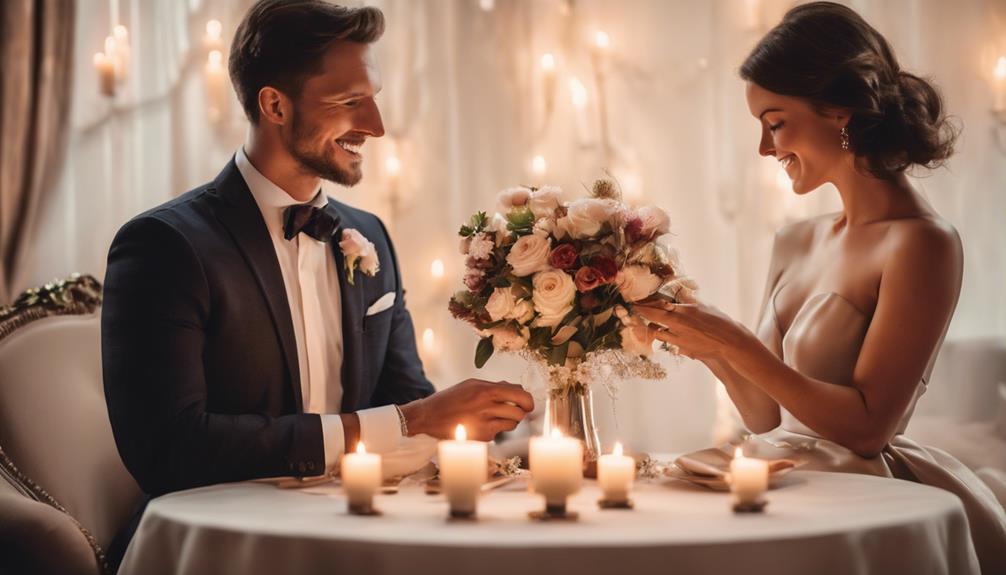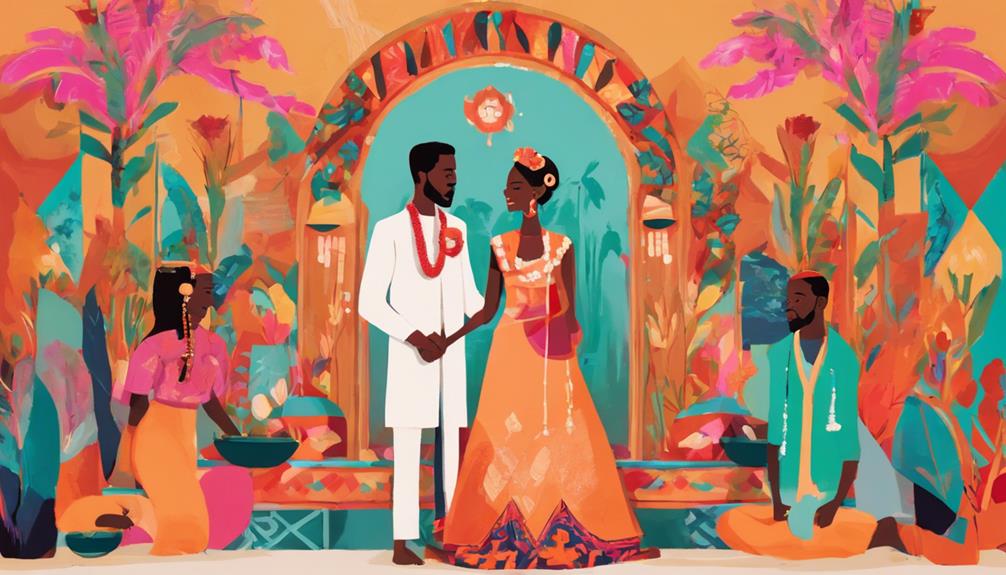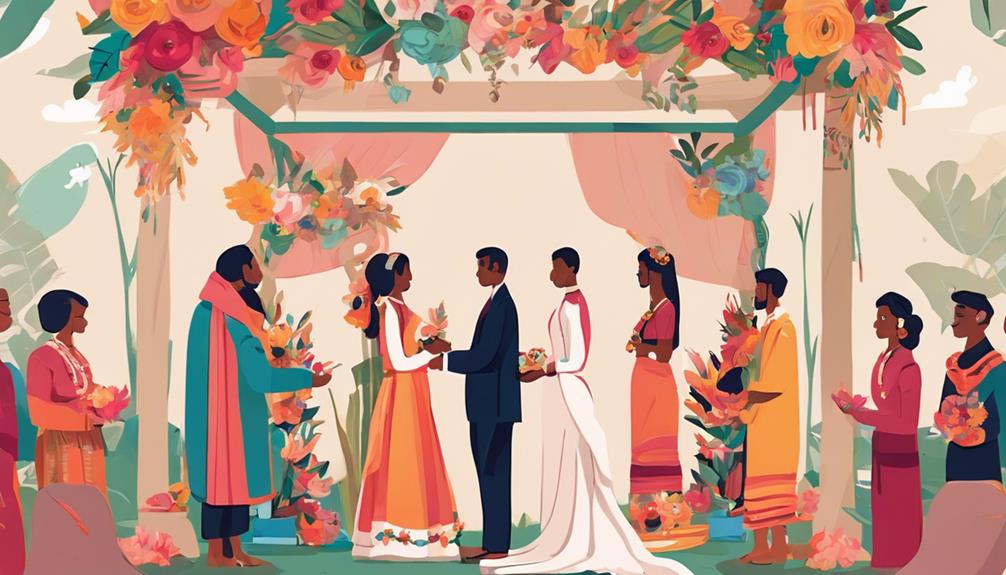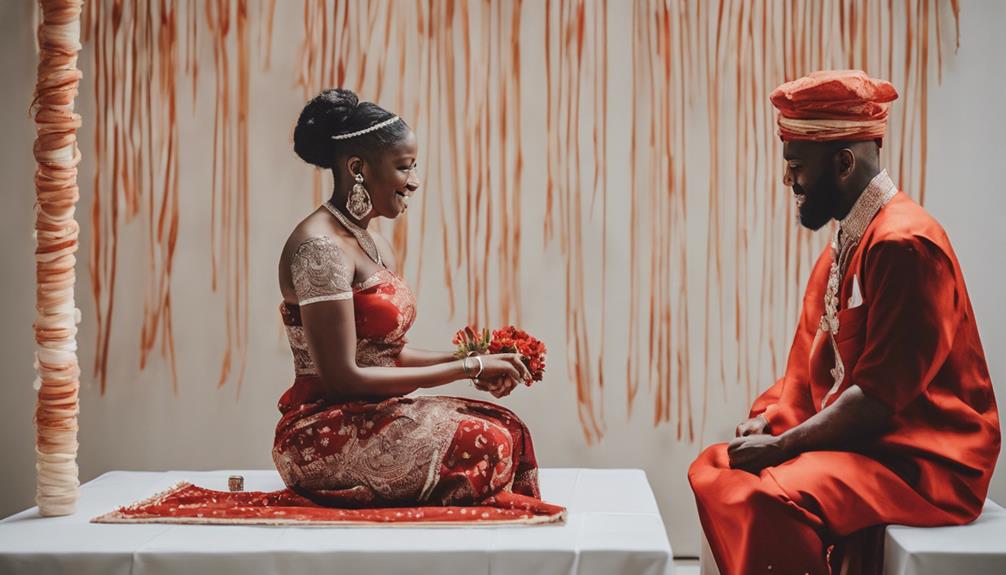When considering the difference between engagement and traditional marriage, you should know engagement is like a promise to marry, typically marked by exchanging an engagement ring. It’s an important step to strengthen your relationship, yet it’s not legally binding. A traditional marriage, however, involves a formal ceremony and is a legally recognized union with social, economic, and emotional responsibilities. Marriage isn’t just a personal milestone but a societal commitment, and ending it requires legal procedures like divorce. Engagement lays the groundwork, while marriage takes on shared responsibilities and legal dimensions. There’s much more to uncover about these stages.
Understanding Engagement

Engagement is a pivotal stage in a relationship where couples officially announce their intent to marry. It’s a special time when you and your partner decide to take your commitment to the next level. This decision is often marked by the giving of an engagement ring, a significant symbol of love and dedication. The engagement ring serves as a tangible reminder of your promise to each other and your mutual intent to move toward marriage.
During the engagement period, you have the opportunity to strengthen your emotional bonds and navigate any challenges that may arise before entering into a marriage. This time is essential as it allows you both to grow together and prepare for the shared life ahead.
It’s a symbolic phase, lacking the legal bindings of marriage, which means there’s flexibility if things don’t go as planned. While not legally binding, engagement is a strong indication that most couples—over 80%—will marry within a year.
This timeframe underscores the engagement period as a preparatory stage, setting the foundation for a lifelong partnership. Embrace this time to solidify your relationship and plan for a fulfilling future together.
Defining Traditional Marriage
As you move from the engagement phase to the domain of traditional marriage, the nature of your commitment deepens and becomes legally recognized. Traditional marriage is a legally binding union that goes beyond the promise made during engagement. It involves a formal ceremony where you’ll exchange vows, marking the beginning of a committed life together. This ceremony not only symbolizes your personal dedication to each other but also signals your union’s acceptance by society.
With this shift, your responsibilities expand considerably. In a traditional marriage, you’re expected to navigate social, economic, and emotional obligations. These responsibilities often include cohabitation, procreation, and family support, which can vary based on cultural and religious contexts.
Unlike engagement, where the focus is on planning a future together, traditional marriage requires managing shared life and responsibilities actively.
The commitment in traditional marriage is reinforced by its legal aspects. If dissolution becomes necessary, it requires legal procedures such as divorce, underscoring its seriousness. This legally binding nature distinguishes marriage from engagement, highlighting the depth of commitment you’re embracing.
Therefore, traditional marriage isn’t just a personal milestone; it’s a considerable societal and legal step forward.
Key Differences Explained

Understanding the key differences between engagement and traditional marriage helps clarify their distinct roles in a relationship journey.
Engagement marks the beginning of a couple’s formal commitment to marry. When you get engaged, it often involves exchanging an engagement ring, symbolizing the promise of a future together. This period is filled with anticipation and planning for the wedding.
On the other hand, marriage represents the fulfillment of that promise, shifting from intent to a legally recognized union, often celebrated with wedding rings that symbolize a commitment to lifelong partnership.
Engagement serves as a public declaration of your intent to marry, but it’s not legally binding. You can end an engagement without legal proceedings.
However, marriage involves a legally enforceable contract, requiring formal vows and societal recognition. If you wish to dissolve a marriage, you must undergo legal processes like divorce, highlighting the depth of commitment involved.
During engagement, you focus on preparing for your wedding day.
Marriage, however, brings shared responsibilities, including cohabitation and financial management. It represents a permanent union with defined rights and obligations, differing greatly from the more flexible nature of engagement.
Cultural Variations
Exploring cultural variations in engagement ceremonies reveals a tapestry of unique traditions and customs that enrich the commitment to marriage. You’ll find that these ceremonies can markedly differ depending on cultural backgrounds.
For example, in Nigeria, engagement ceremonies are vibrant and involve the active participation of families. The Yoruba, Hausa, and Igbo ethnic groups each bring distinct practices to the table, underscoring the rich diversity of cultural expressions surrounding the promise to marry.
In Thai culture, the engagement ceremony, known as Phitee Mun, involves the groom presenting a dowry. The ceremony also includes the tying of a blessed string around the couple’s hands, symbolizing unity and emphasizing the involvement of the community and families.
These cultural variations highlight how deeply rooted traditions can shape the path to a traditional wedding.
While engagement might seem like a simple promise in some places, in others, it holds considerable significance. The customs and rituals involved can mirror those of a marriage ceremony, demonstrating the weight and seriousness of the commitment.
Such cultural nuances influence expectations about familial roles, celebration styles, and even the legal aspects of unions, making each engagement ceremony a unique prelude to marriage.
Symbolism and Rituals

The rich tapestry of cultural variations in engagement ceremonies naturally leads to a closer look at the symbolism and rituals that define these pre-marriage commitments.
Engagements are marked by the exchange of rings, a powerful symbol of the promise to marry. These rings serve as visible tokens of a future union, representing the emotional bond and intention to build a life together. Rituals associated with engagement can vary widely but often include public announcements or intimate gatherings where couples share their joy with family and friends, sometimes receiving blessings.
In contrast, marriage rituals are more elaborate and diverse, often rooted in cultural or religious traditions. While engagement focuses on the promise, marriage signifies the fulfillment of that promise, marked by vows and legal commitments.
Marriage rituals might involve legal documentation and the presence of witnesses, underscoring the societal recognition of the union. Engagement is about planning and anticipation, but marriage is the beginning of a shared life involving cohabitation and mutual responsibilities.
The symbolism of engagement is largely emotional, emphasizing future intentions, while marriage encompasses both emotional and legal dimensions, cementing the bond in the eyes of society.
Conclusion
As you journey from engagement to traditional marriage, you’ll discover how each stage enriches your relationship in unique ways. Engagement sparks the excitement and anticipation of a shared future, while marriage transforms promises into a shared reality through love and commitment. Embrace the symbolism and rituals that each phase offers, understanding their significance in different cultures. This journey strengthens your bond, preparing you for a lifetime of shared experiences, joys, and challenges with your partner.



